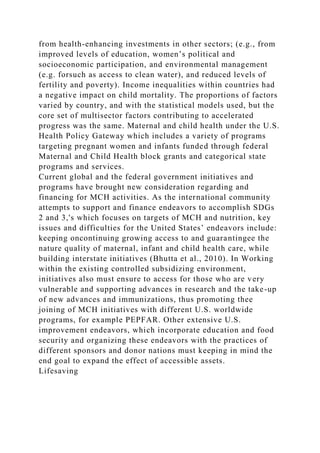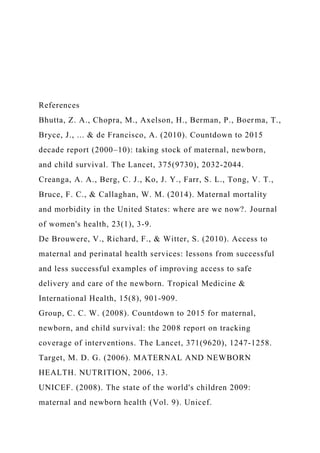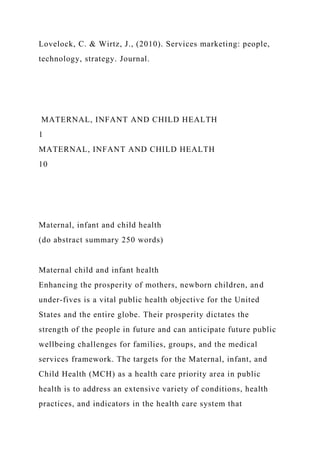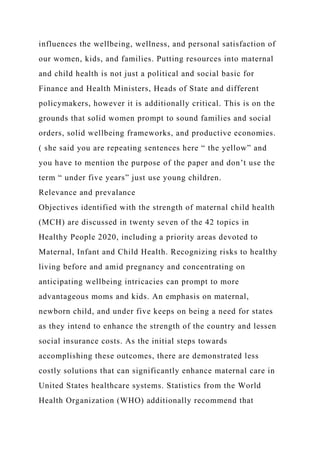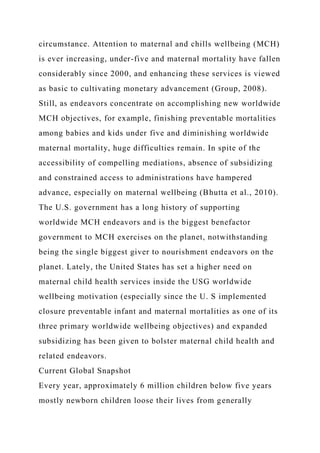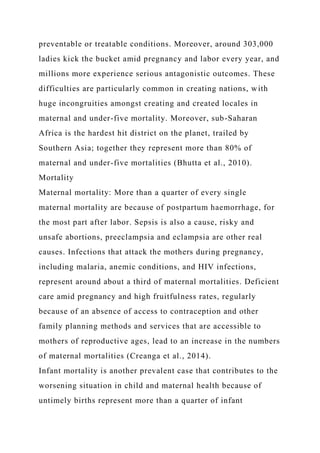Running head MATERNAL, INFANT AND CHILD HEALTH .docx
- 1. Running head: MATERNAL, INFANT AND CHILD HEALTH 1 MATERNAL, INFANT AND CHILD HEALTH 9 Maternal, infant and child health Name Institution Abstract Maternal, infant health is very essential for the progress of any country since they form the pillar of our future generations. United States has made significant strides towards securing the maternal and child health through various initiatives and programs within the country and around the globe. Despite the existence of health care initiatives to promote maternal, infant and child health, maternal and infant mortalities are still recorded on a daily basis in the U.S. Risk factors to maternal, infant and child mortalities include poor and a lack of a antenatal care attendance, unskilled birth attendants,ce and childhood illnesses. More than a quarter of every single maternal mortality is because of postpartum hemorrhaginge, for the most part after labor.
- 2. Infant mortality is another prevalent case that contributes to the worsening situation in child and maternal health, because of untimely births represent more than a quarter of infant mortalities, trailed by mortalities during births and neonatal sepsis. Maternal and child health (MCH) programs concentrate on medical problems concerning related to mothers, children, and families – such as , for example, access to suitable pre-natal and child welfare services, baby mortality mitigation initiatives, emergency medical services, prevention of injuries, infant screening, and administrations to kidschildren children with unique health care needs. The United States is working to prevent maternal deaths, infant mortalities, and child mortalities, and to reduce the prevalence of these incidences. It calls for a multidisciplinary approach in order to eliminate this issue affecting the mothers and children. Reinforcing referral systems and linkages between various levels of hospital-based patient care, and between healthcare organizations providers and the general population, must be a top needpriority. 1- (the things in red is the corrections, if its underline means this is the correct world and if its cross off means you have to delete it) 2- ( the things in yellow you have to delete it and write the topic and the purpose of the paper and I will write it for you at the end of the first paragraph). 3- Change anything about child health and just focus on mortality maternal unless there is something related to the child health so then you can mention that. 4- Scoop of the problem 5- Associated factors 6- solutions Maternal child and infant health Enhancing the prosperity of mothers, newborn children, and
- 3. young children is a vital public health objective for the United States and the entire globe. Their prosperity dictates the strength of the people in the future and can anticipate future public wellbeing challenges for families, groups, and the medical services framework. The targets purpose offor mMaternal , infant, and cChild hHealth (MCH) programs as a health care priority area in public health is to address an extensive variety of conditions and, health practices. There are indicators in the health care system that influences the health and personal satisfaction of our women, kidschildren, and families. Putting resources into maternal and child health is not just a political and social basic for relevant authorities and policymakers, however it is additionally criticalcrucial. This assertion is based on the grounds that solid healthy women prompt toare necessary for sound families and social orders, solid the general wellbeing frameworksof society, and productive economies. The purpose of this paper is to discuss a public health problem in the United States involving maternal, infant and child health. ( here you have to delete this and write this topic and thesis statement because we need to have thesis, topic and claim based of 3 factors)= significance (maternal health is suffering due to women receiving insufficient treatment, not having medical insurance, and being misinformed or uninformed regarding their health; in order to improve maternal health, there must be collaboration among healthcare providers and general population) (write this at the end of first paragraph) Relevance and prevalence Objectives focusing on maternal child health (MCH) are discussed in twenty-seven of the 42 topics in Healthy People 2020, including a priority areas devoted just to ,mMaternal, iInfant and cChild hHealth. Recognizing risks to healthy living before and amid pregnancy and concentrating on anticipating the wellbeing intricacies of wellbeing can prompt topromote more advantageous mommothershealthier mothers and
- 4. kidschildren. An emphasis on maternal, newborn child, and young children keeps on being a need for states as they intend to enhance the strength of the country and lessen social insurance costs. As the initial steps towards accomplishing these outcomes, there are demonstrated solutions that can significantly enhance maternal care in the United States healthcare systems. Statistics from the World Health Organization (WHO) additionally recommend show that around 53% of all child deliveries in developing nations at present happen with the help of a skilled birth attendants, while emergency care are is not available in some states countries (Creanga et al., 2014; De Brouwere, Richard & Witter, 2010)). Most global and national health strategies and programs put a priority on maternal child services. Maternal, infant, and child mortality among women along these lines merits priority urgent consideration because the health of women has suggestions implications foron the strength of their babies, family, and the country. As indicated by the World Bank, of the considerable number of locales on the planet, tropical sub-Saharan Africa positions nations most minimal inon average have the lowest household incomes in the world and future during childbirth, and the most astounding rates ofin mortality for kidschildren below five years. In addition, it is the just a single withthis area has a negative development rate between 1980 and 2000. In these sub-Saharan countries, the household income is low and the mothers are not able to afford and or gain access to maternal child health services that comprisessuch as of antenatal and, postnatal care, family planning, and child immunization. These potentially lead to increasing rates of maternal and infant mortalities. Risk factors in maternal and child health The health of mothers and young children is interrelated and influenced by various factors. Millions of pregnant mothers, new mommothers, and kidschildren encounter extreme ailment
- 5. or demiseillness or death every year, to a great extent from preventable or treatable causes. Poor antenatal care, lack of access to these services, and unskilled birth attendantsce are the contributing factors. Almost all maternal and children mortalities happen in theunder unclear circumstances. But aAttention to maternal and child wellbeing (MCH) is ever increasing, young children and maternal mortality hasve fallen considerably since 2000;, and enhancing these services is viewed as basic necessary to cultivating monetary economic advancement (Group, 2008). Still, as endeavors concentrate on accomplishing new worldwide MCH objectives -, for example, preventing mortality among babies and young children and diminishing worldwide maternal mortality -, huge difficulties remain. In spite of the accessibility of compelling mediations, the absence of subsidizing and constrained access to administrations services hasve hampered advances, especially on for maternal wellbeing (Bhutta et al., 2010). The U.S. government has a long history of supporting worldwide MCH endeavors and is the biggest benefactor government to MCH exercises initiatives on the planet, notwithstanding being the single biggest giver donor to nourishment endeavors on the planet. Lately, the United States has set a higher need on maternal child health services inside the USG worldwide wellbeing motivation (especially since the U. S implemented closure preventable infant and maternal mortalities as one of its three primary worldwide wellbeing objectives) and expanded subsidizing has been given provided to bolster maternal child health and related endeavors. ( in this paragraph you have to talk about the three factors I mentioned in the first paragraph and you don’t have to delete everything, anything related to the mortality maternal you can keep it) Current Global Snapshot Every year, approximately 6 six million children below five years old ( mostly newborns) children around the world loose
- 6. their lives from generally preventable or treatable conditions. Moreover, around 303,000 ladies kick the bucketwomen die amid during pregnancy and labor every each year, and millions more experience serious antagonistic outcomescomplications. These difficulties are particularly common in creating developing nations, with huge incongruities amongst creating and created localesdeveloping and developed areas in maternal and young childreninfant mortality. Moreover, sub-Saharan Africa is the hardest hit district area on the planet, trailed followed by Southern Asia; together they represent more than 80% of maternal and young childreninfant mortalities (Bhutta et al., 2010). Mortality Maternal mortality in which mMore than a quarter of every single maternal mortalitiesy are because of postpartum hemorrhaginge, for the most part after labor. Sepsis is also a cause, risky and unsafe abortions, preeclampsia, and eclampsia are other real causes. Infections that attack the mothers during pregnancy, including malaria, anemic conditions, and HIV infections, represent around about a one-third of maternal mortalities. Deficient care amid during pregnancy and high fruitfulness fertility rates, regularly often because of an absence of access to contraception and other family planning methods and services that are accessible to mothers of reproductive ages, lead to an increase in the numbers of maternal mortalities (Creanga et al., 2014). Infant mortality is another prevalent case that contributes to the worsening situation in child and maternal health, because of untimely births represent more than a one-quarter of infant mortalities, trailed followed by mortalities during births and neonatal sepsis. Low birth weight is a noteworthy risk to consider and a major indirect reason for infant mortalities. Young childrenInfant mortality is due to a wide range of causes, including pneumonia, malaria, diarrhea and some other less common risks to deaths include measles and HIV/AIDS.
- 7. Malnutrition and under-nutrition fundamentally makes the kidschildren' vulnerable to these childhood conditions, just like it is cause by the absence of access to clean water and sanitation (Target, 2006) Maternal, baby infant, and child health results are key to both the present and future of Ohio. To address health service s challenges and enhance wellbeing results for these vulnerable groups, the State of Ohio has cooperated with the Department of Health and Human Sservices to actualize research and quality change programs over across the state. The key regions of centerareas of study incorporate distinguishing and testing successful models of look after treatingmonitoring pregnancyt ladies, enhancing perinatal wellbeing through quality care change activities went for expanding consistence withbased on evidenced-based prescribed procedures, and expanding postpartum clinic attendance rates and type two2 diabetes screenings for ladies with a background marked byof gestational diabetes (Bhutta et al., 2010). Maternal and child health programs Maternal and child health (MCH) programs concentrate on medical problems concerning mothers, children, and families. This includes, for example, access to suitable pre-natal and child welfare services, baby mortality mitigation initiatives, emergency medical services, prevention of injuries, infant screening, and administrations toservices for kidschildren with unique health care needs. The United States has put resources into having mothers and families with good health and trusts this investment that it will spare cashsave money by avoiding highly exorbitant medical conditions and keeping away from the requirement for related support services that accompany it. Health-sector investments accounted for around half the mortality reduction in young children between 1990 and 2010. High-impact interventions and systems strengthening have been made in the U.S, for example for immunization and other child health interventions, skilled birth attendance and maternal and newborn care, and family planning. Other gains resulted come
- 8. from health-enhancing investments in other sectors; (e.g., from improved levels of education, women’s political and socioeconomic participation, and environmental management (e.g. forsuch as access to clean water), and reduced levels of fertility and poverty). Income inequalities within countries had a negative impact on child mortality. The proportions of factors varied by country, and with the statistical models used, but the core set of multisector factors contributing to accelerated progress was the same. Maternal and child health under the U.S. Health Policy Gateway which includes a variety of programs targeting pregnant women and infants funded through federal Maternal and Child Health block grants and categorical state programs and services. Current global and the federal government initiatives and programs have brought new consideration regarding and financing for MCH activities. As the international community attempts to support and finance endeavors to accomplish SDGs 2 and 3,'s which focuses on targets of MCH and nutrition, key issues and difficulties for the United States’ endeavors include: keeping oncontinuing growing access to and guarantingee the nature quality of maternal, infant and child health care, while building interstate initiatives (Bhutta et al., 2010). In Working within the existing controlled subsidizing environment, initiatives also must ensure to access for those who are very vulnerable and supporting advances in research and the take-up of new advances and immunizations, thus promoting thee joining of MCH initiatives with different U.S. worldwide programs, for example PEPFAR. Other extensive U.S. improvement endeavors, which incorporate education and food security and organizing these endeavors with the practices of different sponsors and donor nations must keeping in mind the end goal to expand the effect of accessible assets. Lifesaving
- 9. Solution s The period around childbirth makes a crucial window of chance for preventive measures, actions and services of conditions that complicates maternal and infant health, which can generally end up being risky. Accessibility and availability of skilled birth attendants such as midwives, fundamental and comprehensive emergency reproductive and obstetric care during pregnancy and delivery is most significant. A substantial extent of infant ailments and mortalities can likewise be mitigated by utilizing straightforward, less expensive initiatives during child delivery and during the puerperal period, provided both in the health facility and at home (where presently whereby nearly have of infants die). Consistent and reliable home visits by community health care workers and volunteers at the – both when mothers are delivering and immediately after delivery - can be instrumental in reducing complications and deaths occurring during post-natal period. Fundamental life-saving actions incorporate instantly drying the infant and keeping the infant warm, skin to skin contact, postponed line bracing, starting breastfeeding as quickly as time permits after conveyance, supporting the mother to breastfeed
- 10. solely, giving uncommon special care to low-birth weight babies, and diagnosing threatening issues for infants issues-, for example, asphyxia and sepsis (Group, 2008). Reinforcing referral systems and linkages between various levels of hospital-based patient care, and between health organizations and the general population, must be a top needpriority. Mothers, families and the entire community should be empowered by supporting their participation and proactive heath seeking behavior for pregnancy care, adequate and balanced nutrition, birth readiness, utilization of a gifted chaperon during childbirth, acknowledgment of maternal and infant threat signs, early start and elite breastfeeding. Postnatal administer to ideal birth dispersing is essential (Creanga et al., 2014). In addition, identifying all the pregnant women conducted by community health care workers who will provide continuous antenatal follow-ups and support for the mothers in postnatal period can advance health practices and opportune health seeking behavior if there should arise an occurrence of problems. UNICEF programs have been launched that deal with maternal, child, and infant health. They look to diminish imbalances of care, reinforce wellbeing frameworks, consolidate flexibility and hazard educated arranging, and center consideration on lessening of youthfulreducing young pregnancies (UNICEF, 2008). UNICEF advances an all-encompassing, rights-based approach to the health of maternalmothers, newborns, and
- 11. health of young children. Currently, UNICEF endeavors to upgrade the role of our women, counteract early marriages of girls, promote the education of girls, and prevent female genital mutilation (FGM), and foster the improvement life abilities among the adolescents. The Health Resources and Services Administration (HRSA), which is an agency in the department of health that is responsible for maternal child health (UNICEF, 2008). The Maternal and Child Health Bureau is also responsible for improving the health of mothers, newborns and young children. ( here you have to talk about the solutions for the 3 factors) In conclusion, with a blend of sufficient investment in the most vulnerable groups, practical initiatives, and good leadership, incredible advance progress is conceivable in maternal and child health. More noteworthy venture and strategic planning is required, keeping in mind the end goal is to achieve the most minimized with better, more comprehensive, disaggregated disseminated information, frameworks fortifying frameworks, and development and neighborhood engagement, to defeat the last hindrances and achieve a large number of barred mommothers and their infants. I will use the knowledge on maternal and child health to support for the rights of women and children and end infant and maternal mortality.
- 12. References Bhutta, Z. A., Chopra, M., Axelson, H., Berman, P., Boerma, T., Bryce, J., ... & de Francisco, A. (2010). Countdown to 2015 decade report (2000–10): taking stock of maternal, newborn, and child survival. The Lancet, 375(9730), 2032-2044. Creanga, A. A., Berg, C. J., Ko, J. Y., Farr, S. L., Tong, V. T., Bruce, F. C., & Callaghan, W. M. (2014). Maternal mortality and morbidity in the United States: where are we now?. Journal of women's health, 23(1), 3-9. De Brouwere, V., Richard, F., & Witter, S. (2010). Access to maternal and perinatal health services: lessons from successful and less successful examples of improving access to safe delivery and care of the newborn. Tropical Medicine & International Health, 15(8), 901-909. Group, C. C. W. (2008). Countdown to 2015 for maternal, newborn, and child survival: the 2008 report on tracking coverage of interventions. The Lancet, 371(9620), 1247-1258. Target, M. D. G. (2006). MATERNAL AND NEWBORN HEALTH. NUTRITION, 2006, 13. UNICEF. (2008). The state of the world's children 2009: maternal and newborn health (Vol. 9). Unicef.
- 13. US Department of Health and Human Services. (2010). Maternal, infant, and child health. Healthy people, 2. COLGATE PALMOLIVE Colgate-Palmolive Company Case Name University 3. Marketing Mix (4 P’s) proposed for the launch of CMCP+SAN in Brazil c. Promotion According to Bonecker, Pucca Junior, Costa and Pitts (2012), it has been found that promotion strategy is also known as the marketing communication strategy which includes the
- 14. advertising the products and services by below the line (BTL) and above the line (ATL) activities. Promotional activities are carried out by the marketers and business companies in order to raise customer awareness for the particular brand and product. Promotional strategies are performed by the business organisations to gain the customer’s attention and increase the customer’s demand whereas; Lovelock and Wirtz (2010) stated that the case of Colgate-Palmolive Company states the promotional activities initiated by the company to enter in Brazil. Colgate entered in Brazil through the awareness programs based on the promotions and oral care by Colgate toothpaste. As described by Gordon (2012), it has been found that promotion is related to the awareness and how companies spread information about their products and services under the influence of customer care. However, in the case of Colgate- Palmolive Company, the company entered into a huge promotional program to make the customer aware about the oral care. Schools, housing societies and communities were targeted in order to spread awareness about Colgate’s oral care. BSBF operating program helped children in schools and churches to understand the importance of oral care and hygiene. In the viewpoint of Bernhardt, Mays and Hall (2012), it has been found that strategic alliance and partnerships with the existing (domestic) firms or association helps the business
- 15. companies to gain the attention in the society or region they are going to operate in. The Company made a strategic alliance with Ministry of Health of Brazil and entered the market with their approval. The oral health education program was designed to educate the 55 million children in Brazil. The main challenge was faced by Colgate-Palmolive was with the positioning and launching of CMCP+SAN toothpaste. The product itself claimed that it is an improved and innovative formula for oral care but unfortunately was not recommended by the dentists. However, Colgate-Palmolive CMCP+SAN was famous among the consumers for fresh breath and pleasant sensation. d. Price In the views of by Gordon (2012), it has been evaluated that pricing is the main factor which influences the customer preference, customer retention and customer loyalty whereas; it has been found that most of the consumer pay higher prices for the sake of quality they are getting. Marketers apply pricing strategies by under the consideration of consumer demographics by targeting the need of the segment. The pricing strategies are applied to get the customer’s attention and maximise the revenue in the long run. However, the case of Colgate- Palmolive CMCP-SAN states that the launching of toothpaste in Brazil with CMCP+SAN was an effective idea. The prices were set for the consumers of all class, as Colgate-Palmolive targeted the 55 million people in Brazil the prices were reasonable and
- 16. affordable by every household. The main purpose of implementing reasonable and approachable pricing strategy to attract the consumers. As per the analysis of Hollensen (2015), fair pricing is the concept that falls in the budget of the consumer whereas; it has been found that low prices of the products and services increase the demand in the market. Colgate-Palmolive CMCP+NAS entered the market and made a visible appearance on the shelf. The consumer demand among youngsters increased in the market due to the prices meet their demands and fresh sensation of the toothpaste. Colgate-Palmolive sustained in the Brazilian market due to its pricing strategy along with the provision of reason to believe (RTB) to the consumers. References Bernhardt, J.M., Mays, D. & Hall, A.K., (2012). Social marketing at the right place and right time with new media. Journal of Social Marketing, 2(2), pp.130-137. Bonecker, M., Pucca Junior, G.A., Costa, P.B. & Pitts, N., (2012). A social movement to reduce caries prevalence in the world. Brazilian oral research, 26(6), pp.491-492. Gordon, R., (2012). Re-thinking and re-tooling the social marketing mix. Australasian Marketing Journal (AMJ), 20(2), pp.122-126. Hollensen, S., (2015). Marketing management: A relationship approach. Pearson Education.
- 17. Lovelock, C. & Wirtz, J., (2010). Services marketing: people, technology, strategy. Journal. MATERNAL, INFANT AND CHILD HEALTH 1 MATERNAL, INFANT AND CHILD HEALTH 10 Maternal, infant and child health (do abstract summary 250 words) Maternal child and infant health Enhancing the prosperity of mothers, newborn children, and under-fives is a vital public health objective for the United States and the entire globe. Their prosperity dictates the strength of the people in future and can anticipate future public wellbeing challenges for families, groups, and the medical services framework. The targets for the Maternal, infant, and Child Health (MCH) as a health care priority area in public health is to address an extensive variety of conditions, health practices, and indicators in the health care system that
- 18. influences the wellbeing, wellness, and personal satisfaction of our women, kids, and families. Putting resources into maternal and child health is not just a political and social basic for Finance and Health Ministers, Heads of State and different policymakers, however it is additionally critical. This is on the grounds that solid women prompt to sound families and social orders, solid wellbeing frameworks, and productive economies. ( she said you are repeating sentences here “ the yellow” and you have to mention the purpose of the paper and don’t use the term “ under five years” just use young children. Relevance and prevalance Objectives identified with the strength of maternal child health (MCH) are discussed in twenty seven of the 42 topics in Healthy People 2020, including a priority areas devoted to Maternal, Infant and Child Health. Recognizing risks to healthy living before and amid pregnancy and concentrating on anticipating wellbeing intricacies can prompt to more advantageous moms and kids. An emphasis on maternal, newborn child, and under five keeps on being a need for states as they intend to enhance the strength of the country and lessen social insurance costs. As the initial steps towards accomplishing these outcomes, there are demonstrated less costly solutions that can significantly enhance maternal care in United States healthcare systems. Statistics from the World Health Organization (WHO) additionally recommend that
- 19. around 53% of all child deliveries in developing nations at present happen with the help of a skilled birth attendants, while emergency care are not available in some states (Creanga et al., 2014; De Brouwere, Richard & Witter, 2010)). It subsequently shocks no one that both global and national health strategies and mediation conventions put premium on maternal child services. ( she said this sentence doesn’t make any sense and she didn’t understand it) Maternal, infant and child mortality among ladies along these lines merit priority consideration because the health of women has suggestions on the strength of their babies, family and the country. As indicated by World Bank, of the considerable number of locales on the planet, tropical sub-Saharan Africa positions most minimal in household income and future during childbirth, and most astounding in mortality for kids below five years. In addition, it is the just a single with a negative development rate between 1980 and 2000. ( talk about how the income is low and because of this they don’t have access to facilities. This is the cause of high infant mortality rate) Risk factors in maternal and child health The wellbeing of mothers and kids is interrelated and influenced by various factors. Millions of pregnant mothers, new moms, and kids encounter extreme ailment or demise every year, to a great extent from preventable or treatable causes. Almost all maternal and children mortalities happen in the unclear
- 20. circumstance. Attention to maternal and chills wellbeing (MCH) is ever increasing, under-five and maternal mortality have fallen considerably since 2000, and enhancing these services is viewed as basic to cultivating monetary advancement (Group, 2008). Still, as endeavors concentrate on accomplishing new worldwide MCH objectives, for example, finishing preventable mortalities among babies and kids under five and diminishing worldwide maternal mortality, huge difficulties remain. In spite of the accessibility of compelling mediations, absence of subsidizing and constrained access to administrations have hampered advance, especially on maternal wellbeing (Bhutta et al., 2010). The U.S. government has a long history of supporting worldwide MCH endeavors and is the biggest benefactor government to MCH exercises on the planet, notwithstanding being the single biggest giver to nourishment endeavors on the planet. Lately, the United States has set a higher need on maternal child health services inside the USG worldwide wellbeing motivation (especially since the U. S implemented closure preventable infant and maternal mortalities as one of its three primary worldwide wellbeing objectives) and expanded subsidizing has been given to bolster maternal child health and related endeavors. Current Global Snapshot Every year, approximately 6 million children below five years mostly newborn children loose their lives from generally
- 21. preventable or treatable conditions. Moreover, around 303,000 ladies kick the bucket amid pregnancy and labor every year, and millions more experience serious antagonistic outcomes. These difficulties are particularly common in creating nations, with huge incongruities amongst creating and created locales in maternal and under-five mortality. Moreover, sub-Saharan Africa is the hardest hit district on the planet, trailed by Southern Asia; together they represent more than 80% of maternal and under-five mortalities (Bhutta et al., 2010). Mortality Maternal mortality: More than a quarter of every single maternal mortality are because of postpartum haemorrhage, for the most part after labor. Sepsis is also a cause, risky and unsafe abortions, preeclampsia and eclampsia are other real causes. Infections that attack the mothers during pregnancy, including malaria, anemic conditions, and HIV infections, represent around about a third of maternal mortalities. Deficient care amid pregnancy and high fruitfulness rates, regularly because of an absence of access to contraception and other family planning methods and services that are accessible to mothers of reproductive ages, lead to an increase in the numbers of maternal mortalities (Creanga et al., 2014). Infant mortality is another prevalent case that contributes to the worsening situation in child and maternal health because of untimely births represent more than a quarter of infant
- 22. mortalities, trailed by mortalities during births and neonatal sepsis. Low birth weight is a noteworthy risk to consider and a major indirect reason for infant mortalities. Under-five mortality are due to a wide range of causes including pneumonia, malaria, diarrhea and some other less common risks to deaths include measles and HIV/AIDS. Malnutrition and under-nutrition fundamentally makes the kids' vulnerable to these childhood conditions, just like it is cause by the absence of access to clean water and sanitation (Target, 2006) Maternal, baby and child health results are key to both the present and future of Ohio. To address health services challenges and enhance wellbeing results for these vulnerable groups, the State of Ohio has cooperated with Department of Health services to actualize research and quality change programs over the state. The key regions of center incorporate distinguishing and testing successful models of look after treating pregnant ladies, enhancing perinatal wellbeing through quality care change activities went for expanding consistence with evidenced-based prescribed procedures, and expanding postpartum clinic attendance rates and type 2 diabetes screenings for ladies with a background marked by gestational diabetes(Bhutta et al., 2010). Maternal and child health programs
- 23. Maternal and child health (MCH) programs concentrate on medical problems concerning mothers, children and families, for example, access to suitable pre-natal and child welfare services, baby mortality mitigation initiatives, emergency medical services, prevention of injuries, infant screening, and administrations to kids with unique health care needs. United States put resources into having mothers and families with good health and trust that it will spare cash by avoiding highly exorbitant medical conditions and keeping away from the requirement for related support services that accompany it. ( talk about U.S policies, resources and how they do that and what the US government do to make women healthy) Current global and the federal government initiatives and programs have brought new consideration regarding and financing for MCH activities. As the international community attempts to support and finance endeavors to accomplish SDGs 2 and 3's which focuses on targets of MCH and nutrition, key issues and difficulties for United States endeavors include: keeping on growing access to and guarantee the nature of maternal, infant and child health care, while building interstate initiatives (Bhutta et al., 2010). In the existing controlled subsidizing environment to access those who are very vulnerable and supporting advances in research and take-up of new advances and immunizations thus promote joining of MCH initiatives with different U.S. worldwide programs, for example
- 24. PEPFAR. Other extensive U.S. improvement endeavors, which incorporate education and food security and organizing these endeavors with the practices of different sponsors and donor nations keeping in mind the end goal to expand the effect of accessible assets. Lifesaving







